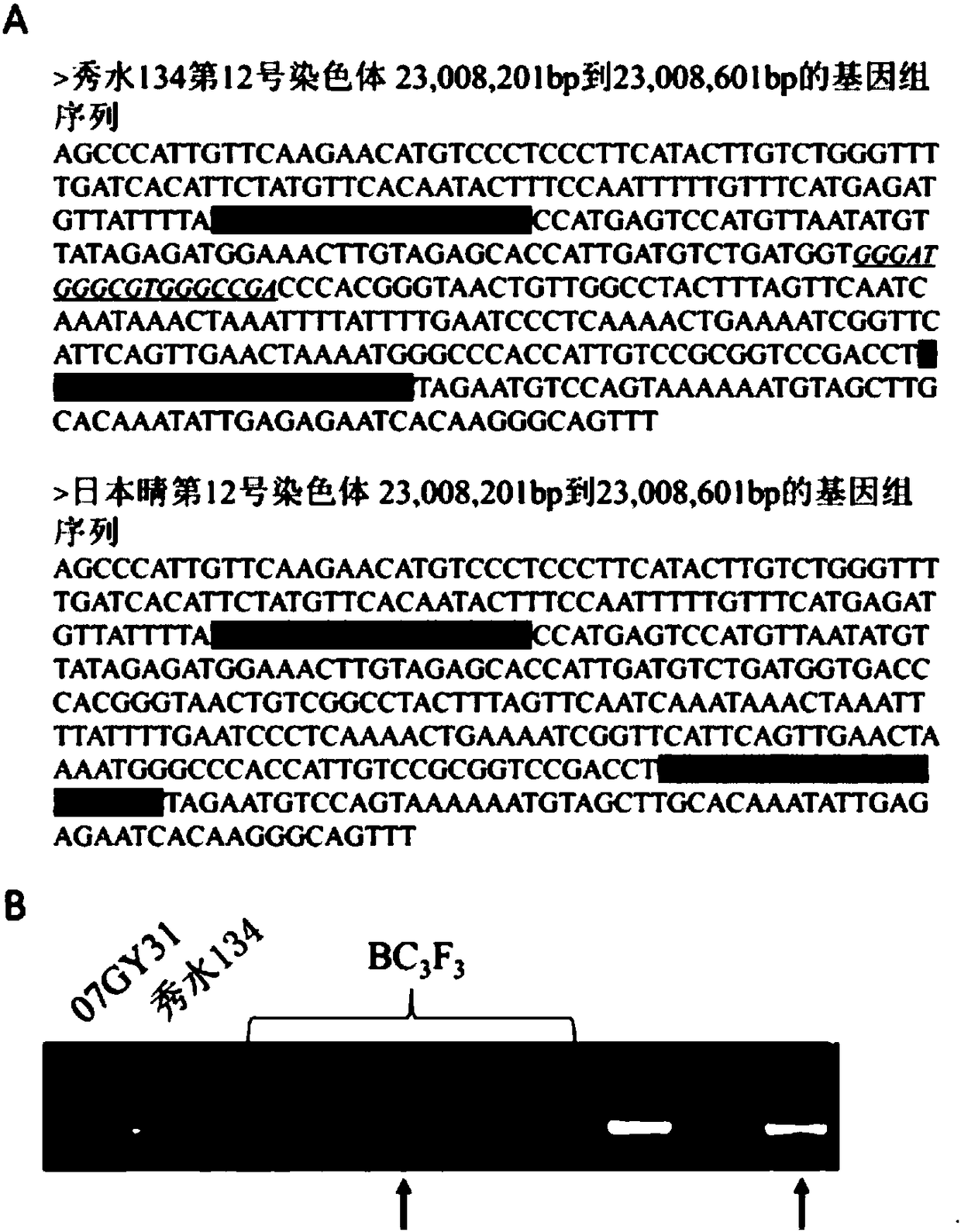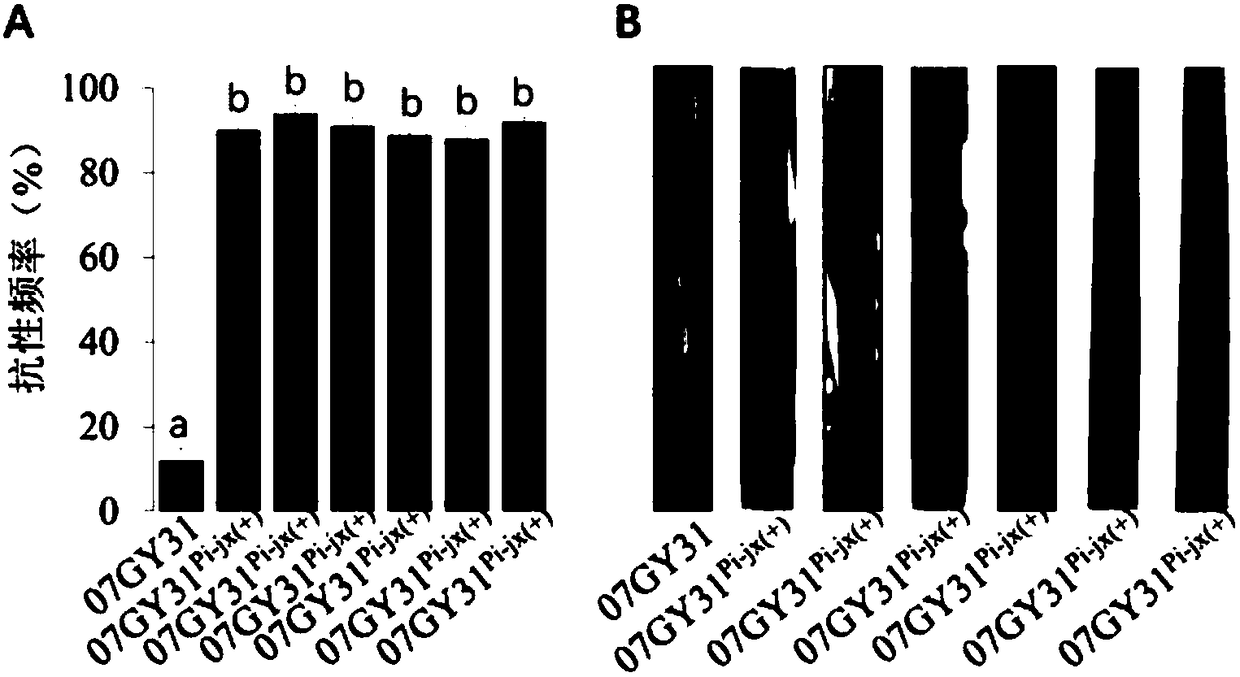Rice blast-resistant locus Pi-jx and Indel marker primers and breeding application thereof
A technology for marking primers and pi-jx, which is applied in the field of crop genetics and breeding, and can solve problems such as false positives in GWAS positioning results
- Summary
- Abstract
- Description
- Claims
- Application Information
AI Technical Summary
Problems solved by technology
Method used
Image
Examples
Embodiment 1
[0039] Example 1: GWAS mapping of rice blast resistance genetic loci
[0040] 1). The 199 japonica rice varieties used for GWAS positioning come from Jiangsu, Zhejiang, Anhui, Shandong, Tianjin and other provinces (Table 1). 50 seeds of each variety were taken out and placed in a constant temperature oven at 45°C for 5 days to break dormancy, and then put Put them into an incubator for germination (germination condition: 45°C / 12 hours day and night, light intensity: 25,000Lx), and when the seedlings grow to the 4-leaf stage, remove the fresh leaves for genomic DNA extraction.
[0041] 2). Genomic DNA extraction. Take 200mg young leaves of each variety, cut them into pieces and put them into a 2ml centrifuge tube, and liquid nitrogen quickly freezes the leaves in the centrifuge tube, and grind them to powder. DNA was extracted according to the DNASoltis Lab CTAB DNA Extraction Protocol (Reference: Doyle & Doyle, 1987; and Cullings 1992) Revised November 14, 2002). The obtained...
Embodiment 2
[0046] Example 2: Pi-jx linked polymorphic marker development
[0047] According to the genome sequence of Xiushui 134 and Nipponbare, there is a fragment deletion from 23,008,201bp to 23,008,01b ( figure 2 A), through the software Primer primer 5.0 design Indel marker, upstream primer P1 Pi-jx -F: GAGATTTGTTGATTGTGTCC (SEQ ID NO.1); downstream primer P1 Pi-jx -R: CTCTAAACAACTAACACAGG (SEQ ID NO.2), the size of the target fragment in Xiushui 134 is 326bp, while the size of the band in Nipponbare is 310bp ( figure 2 B). The PCR reaction system is 25 μl, including 16.4 μl of ddH 2 O, 2.5μl of 10×PCR buffer, 2μl of 2.5mM / μldNTP, 2μl of 10mmol / μl P1 Pi-jx -F, 2 μl of 10 mmol / μl P1 Pi-jx -R, 0.1ul of TAKARA's Taq enzyme (5u / ul). The PCR reaction program and conditions are as follows: program 1: pre-denaturation at 95°C for 10 minutes; program 2: denaturation at 94°C for 45 seconds, annealing at 50.5°C for 45 seconds; program 3: extension at 72°C for 35 seconds; program 4: r...
Embodiment 3
[0048] Example 3: Marker-assisted selection improves resistance of susceptible varieties
[0049] In August 2014, F was obtained by crossing Xiushui 134 with 07GY31 1 , planted F in Sanya, Hainan in December of the same year 1 , in March 2015 the F 1 Backcross with 07GY31 and get 100 grains of BC with 07GY31 as the background 1 f 1 The seeds were planted in Yangzhou in May of the same year in BC 1 f 1 , get 65 strains of BC 1 f 1 Plant, each plant gets 0.2g fresh leaf and is used for DNA extraction, and DNA extraction method is with reference to step 2, and the DNA after extraction will carry disease-resistant genotype (Pi-jx (+) ) single plant was selected, combined with field agronomic traits, 5 plants were selected to carry Pi-jx (+) The plants continued to backcross with 07GY31 to obtain 5 BC 2 f 1 Each line planted 20 plants in Sanya in December; the above BC was taken in January 2016 2 f 1 DNA was extracted from the leaves of plants in each line for marker de...
PUM
 Login to View More
Login to View More Abstract
Description
Claims
Application Information
 Login to View More
Login to View More - R&D
- Intellectual Property
- Life Sciences
- Materials
- Tech Scout
- Unparalleled Data Quality
- Higher Quality Content
- 60% Fewer Hallucinations
Browse by: Latest US Patents, China's latest patents, Technical Efficacy Thesaurus, Application Domain, Technology Topic, Popular Technical Reports.
© 2025 PatSnap. All rights reserved.Legal|Privacy policy|Modern Slavery Act Transparency Statement|Sitemap|About US| Contact US: help@patsnap.com



